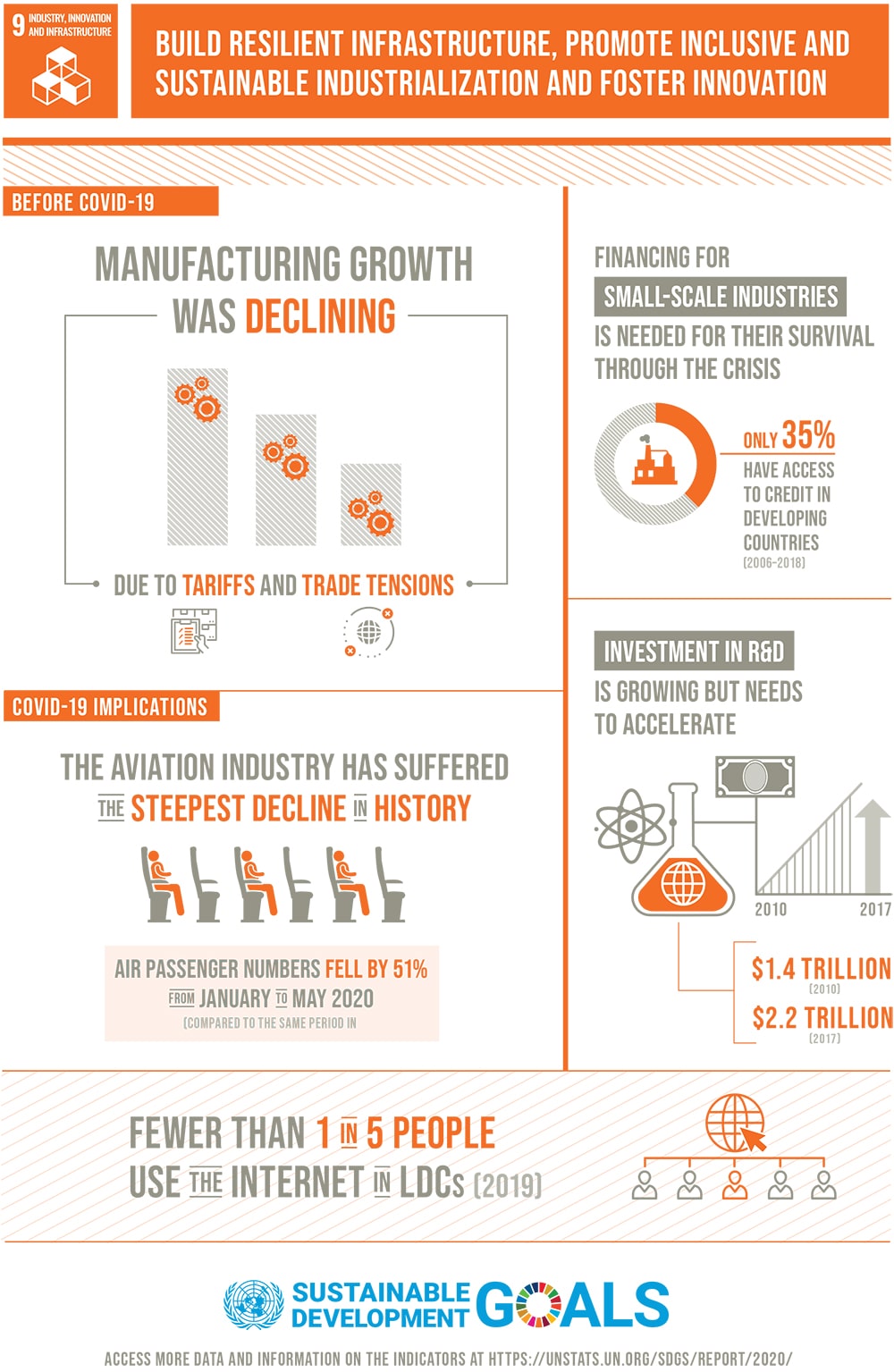Why is this important
For a society to progress in terms of economy, living conditions and ecology, it requires sustainable development of infrastructure and industries, and potential for sustainable innovation. Essentially, investment in infrastructure, sustainably developed industries and technological progress are heavy contributors to economic growth, climate action and social development.
With the increasing urban population dwelling in cities and towns, the need arises for information and communication technologies, evolving industries, and improved infrastructure for clean energy and transportation. Industrial sustainability and inclusivity is of primary importance to ensure that the growing migrants from rural areas are provided with jobs that are fair and decent. Infrastructural efficiency is required to provide improved living conditions for the population as well as create a clean and green society. With the recent rise in natural disasters it is also essential for the infrastructure to be modelled and developed in a climate resilient manner.
This goal facilitates economic growth through creating employment, and through increased productivity by motivated competitive economic forces. Innovation helps aid infrastructure and industries to gain efficiency and sustainability. The Internet is one such innovation and technology that has revolutionized the ease of economic activity, education and health among other things. Developing such technologies only makes a society more advanced.
However, according to UNDP, approximately 4 billion people lack access to the internet, out of which around 90% come from developing and underdeveloped nations. This along with the proportion of population lacking facilities like access to sanitation and energy also highlight the inequitable distribution of certain resources.
Therefore it is essential to not only develop and improve infrastructure, industrial activities and technology, but also increase the accessibility and distribution of these resources and capabilities.

Understanding the root cause
Lack of infrastructure causes a society to be unstructured and deprived of facilities necessary for proper living standards, thus either causing people to enter into or further deteriorating the existing poverty.
Industries have ramped up the rate of pollution both due to the volume of their production and scale of their size. Lack of industrial processing and technology also affects sectors such as health, sanitation and education further damaging the living standards of people. As per the Sustainable Development Goals Report-2020 dynamic strategies for sustainable industries, resilient infrastructure and research in technologies leads to international economic gains through trades and exchanges.
Therefore the requirement to fulfill this goal lies at the very physical and economic foundations of a society. According to the SDG progress report-2020, the proportion of GDP dedicated to investing in research and development has remained the same since 2017, accounting for 1.7% of the GDP, and as low as 1% in developing nations. This lack of increasing investment is reflected in the decline in global manufacturing, which is additionally affected by tariffs.
The coronavirus pandemic further deteriorated the situation by causing decline in prominent industries such as airline industry, dining industry etc. The Sustainable Development Goals Report-2020 has also shed light onto the need for improved and resilient infrastructure, as facilities such as healthcare centers and sanitation services were unable to contain the virus till increased investment and effort had been poured in the time of crisis.
Changemakers striving for sustainable and resilient infrastructure
There are various international bodies, councils and organizations that focus and emphasize on the importance of resilient infrastructure paired with sustainable and emerging technologies and industries. The United Nations Industrial Development Organization (UNIDO) is an entity of the UN dedicated to ensure industrial development in remote areas in a sustainable manner, while also improving the sustainability of the already industrialized part of the world, through their ‘Green Industry Initiative’. Another important body is the Coalition for Disaster Resilient Infrastructure (CDRI), which is a coalition of international organizations, UN agencies, countries and their respective private sector and development banks. The main aim of this organization is to promote disaster resilient infrastructure that can absorb any shocks caused by climate change. The Private Sector Alliance for Disaster Resilient Societies (ARISE) is an alliance of a network of entities coming from the private sector. This alliance is headed by the UN Office for Disaster Risk Reduction (UNDRR).
What youth can do as a TAL transformer
The action to ensure resilience and sustainability comes from the economic structures and social institutions that govern and overlook the society. People as part of the community with decision making power can ensure the same within their immediate vicinity.
What you as a transformer for the society can do, is use social advocacy, philanthropy and entrepreneurial/business ideas in an innovative manner to provide a progressive direction for reaching the goal. Instances of which are as follows:
Social Advocacy
- Advocate for sustainable standards to be maintained in immediate, organizations, educational institutions and residencies
- Utilise social media to spread awareness regarding the need for sustainable economic practices and technologies in industries.
- Use media to pressurize the civil society and policy makers regarding the need for resilient and eco-friendly infrastructure
Social Philanthropy
- Fund for local level climate resilient infrastructure
- Finance models of mobile connectivity for remote areas
- Finance eco-friendly models for residencies
Social Entrepreneurship
- Develop climate and disaster resilient models to support infrastructure
- Improve and innovate technologies for greater communication networking
- Reduce cost through efficient technologies
References
United Nations (2020). The Sustainable Development Goals Report 2020. New York: United Nations, Department of Economic and Social Affairs. Retrieved from https://unstats.un.org/sdgs/report/2020/
https://www.undp.org/sustainable-development-goals#industry-innovation-and-infrastructure
Sustainability Program Manager
